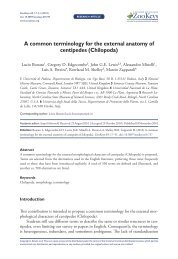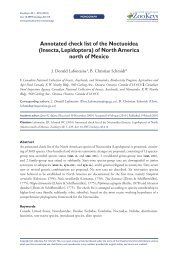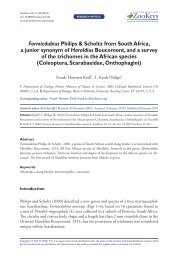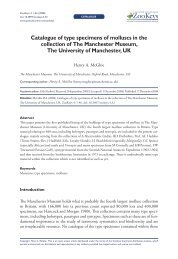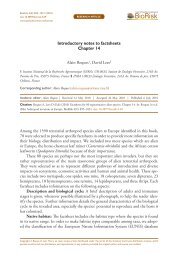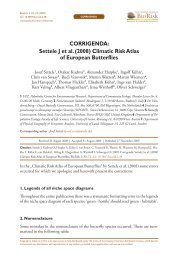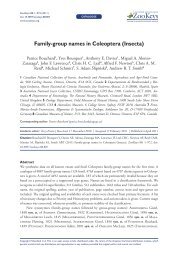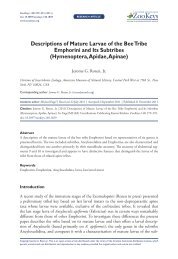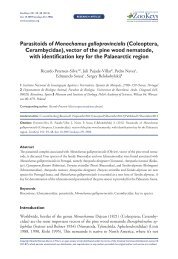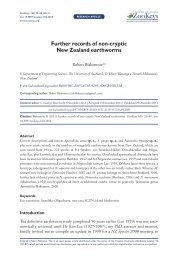of the Balkan Peninsula? - Pensoft Publishers
of the Balkan Peninsula? - Pensoft Publishers
of the Balkan Peninsula? - Pensoft Publishers
Create successful ePaper yourself
Turn your PDF publications into a flip-book with our unique Google optimized e-Paper software.
ZooKeys 100: 487–502 (2011)<br />
How unique is <strong>the</strong> tiger beetle fauna (Coleoptera, Cicindelidae) <strong>of</strong> <strong>the</strong> <strong>Balkan</strong> <strong>Peninsula</strong>? 487<br />
doi: 10.3897/zookeys.100.1542<br />
www.zookeys.org<br />
Research article<br />
A peer-reviewed open-access journal<br />
Launched to accelerate biodiversity research<br />
How unique is <strong>the</strong> tiger beetle fauna (Coleoptera,<br />
Cicindelidae) <strong>of</strong> <strong>the</strong> <strong>Balkan</strong> <strong>Peninsula</strong>?<br />
Radomir Jaskuła<br />
Department <strong>of</strong> Invertebrate Zoology and Hydrobiology, University <strong>of</strong> Łódź, Banacha 12/16, 90-237 Łódź, Poland<br />
Corresponding author: Radomir Jaskuła (radekj@biol.uni.lodz.pl)<br />
Academic editor: Th. Assmann | Received 30 November 2009 | Accepted 31 January 2011 | Published 20 May 2011<br />
Citation: Jaskuła R (2011) How unique is <strong>the</strong> tiger beetle fauna (Coleoptera, Cicindelidae) <strong>of</strong> <strong>the</strong> <strong>Balkan</strong> <strong>Peninsula</strong>?<br />
In: Kotze DJ, Assmann T, Noordijk J, Turin H, Vermeulen R (Eds) Carabid Beetles as Bioindicators: Biogeographical,<br />
Ecological and Environmental Studies. ZooKeys 100: 487–502. doi: 10.3897/zookeys.100.1542<br />
Abstract<br />
The tiger beetle fauna <strong>of</strong> <strong>the</strong> <strong>Balkan</strong> <strong>Peninsula</strong> is one <strong>of</strong> <strong>the</strong> richest in Europe and includes 19 species or<br />
41% <strong>of</strong> <strong>the</strong> European tiger beetle fauna. Assembled by <strong>the</strong>ir biogeographical origins, <strong>the</strong> <strong>Balkan</strong> tiger<br />
beetle species fall into 14 different groups that include, Mediterranean, Middle Oriental, Central Asiatic,<br />
Euro-Siberian, South and East European, Pannonian-Sarmatian, West Palaearctic, Turano-European and<br />
Afrotropico Indo-Mediterranean species. The Mediterranean Sclerophyl and <strong>the</strong> Pontian Steppe are <strong>the</strong><br />
<strong>Balkan</strong> biogeographical provinces with <strong>the</strong> highest species richness, while <strong>the</strong> <strong>Balkan</strong> Highlands has <strong>the</strong><br />
lowest Cicindelidae diversity. Most species are restricted to single habitat types in lowland areas <strong>of</strong> <strong>the</strong><br />
<strong>Balkan</strong> <strong>Peninsula</strong> and only Calomera aulica aulica and Calomera littoralis nemoralis occur in respectively<br />
3 and 4 different types <strong>of</strong> habitat. About 60% <strong>of</strong> all <strong>Balkan</strong> Cicindelidae species are found in habitats<br />
potentially endangered by human activity.<br />
Keywords<br />
<strong>Balkan</strong> <strong>Peninsula</strong>, biodiversity, distribution, Europe, zoogeography<br />
Introduction<br />
Tiger beetles occur world-wide, with <strong>the</strong> exception <strong>of</strong> <strong>the</strong> polar regions and some oceanic<br />
islands (Cassola and Pearson 2000, Pearson and Vogler 2001). Detailed studies<br />
from different regions show that many species have narrow habitat specialization and<br />
occur only in one or at most in few very similar types <strong>of</strong> habitat. As a result, tiger<br />
Copyright Radomir Jaskuła. This is an open access article distributed under <strong>the</strong> terms <strong>of</strong> <strong>the</strong> Creative Commons Attribution License, which<br />
permits unrestricted use, distribution, and reproduction in any medium, provided <strong>the</strong> original author and source are credited.
488<br />
Radomir Jaskuła / ZooKeys 100: 487–502 (2011)<br />
beetles have become a significant global flagship group for beetle conservation used as<br />
biological indicators for determining global and regional patterns <strong>of</strong> biodiversity (Knisley<br />
and Hill 1992; Pearson and Cassola 1992, 2007; Carroll and Pearson 1998a, b;<br />
Andriamampianina et al 2000; Pearson and Vogler 2001; Arndt et al. 2005). In most<br />
species, adult beetles are diurnal and highly mobile, while larvae are sedentary and live<br />
in burrows constructed in <strong>the</strong> substrate where <strong>the</strong> eggs are oviposited (Pearson 1988).<br />
Both imagines and larvae are predators that prey on small invertebrates, a characteristic<br />
that makes <strong>the</strong>m potentially natural biological controls <strong>of</strong> pests with an economic<br />
value (Rodriguez et al. 1998).<br />
The <strong>Balkan</strong> <strong>Peninsula</strong> is part <strong>of</strong> <strong>the</strong> Mediterranean basin. It is one <strong>of</strong> <strong>the</strong> 25<br />
most important world hotspot areas <strong>of</strong> biodiversity (Myers et al. 2000). Toge<strong>the</strong>r<br />
with two o<strong>the</strong>r South European peninsulas, <strong>the</strong> Iberian and <strong>the</strong> Italian, <strong>the</strong> <strong>Balkan</strong>s<br />
were <strong>the</strong> most important terrestrial Pleistocene glacial refugia in Europe. Phylogeographical<br />
studies on many different groups <strong>of</strong> animals and plants show that <strong>the</strong>se<br />
areas are regions from which <strong>the</strong> re-colonisation <strong>of</strong> nor<strong>the</strong>rn Europe started after <strong>the</strong><br />
last glaciation period (Hewitt 1996, 1999; Blonden and Aronson 1999; Thompson<br />
2005). Weiss and Ferrand (2007) suggest that high biodiversity <strong>of</strong> <strong>the</strong> South European<br />
<strong>Peninsula</strong>s, including <strong>the</strong> <strong>Balkan</strong> <strong>Peninsula</strong>, can be explained by relatively high<br />
climatic stabilization <strong>of</strong> this region as well as heterogeneous landscapes occurring<br />
in this area. Moreover, <strong>the</strong> <strong>Balkan</strong>s have served as an important natural bridge for<br />
historical dispersal between Asia Minor and nor<strong>the</strong>rn, western and central Europe<br />
(Crnobrnja-Isailovic 2007).<br />
The first data on <strong>the</strong> tiger beetle fauna <strong>of</strong> <strong>the</strong> <strong>Balkan</strong> <strong>Peninsula</strong> were published<br />
at <strong>the</strong> end <strong>of</strong> <strong>the</strong> 19 th and beginning <strong>of</strong> <strong>the</strong> 20 th century (Reitter 1881; Horn and<br />
Roeschke 1891; Apfelbeck 1904–1907). Since <strong>the</strong>n, more than 40 papers have been<br />
published on this topic, many <strong>of</strong> which however only describe information on a single<br />
species or present incomplete faunistic and taxonomic data. Recently more complete<br />
information on <strong>the</strong> fauna <strong>of</strong> some regions have been summarized for Bulgaria (Guéorguiev<br />
and Guéorguiev 1995), Montenegro (Jaskuła et al. 2005), Albania (Guéorguiev<br />
2007; Jaskuła 2007a), Romania (Cassola and Jaskuła 2004; Jaskuła 2007b), Greece<br />
(Franzen 2005; Jaskuła et al. – in preparation) and <strong>the</strong> European part <strong>of</strong> Turkey (Cassola<br />
1999; Avgın and Özdikmen 2007).<br />
The aim <strong>of</strong> this paper is to summarize knowledge on <strong>the</strong> diversity <strong>of</strong> tiger beetles in<br />
<strong>the</strong> <strong>Balkan</strong> <strong>Peninsula</strong> with particular emphasis on total group diversity, zoogeographical<br />
composition, distribution, and ecological preferences <strong>of</strong> <strong>the</strong> species.<br />
Study area<br />
We can define <strong>the</strong> <strong>Balkan</strong> <strong>Peninsula</strong> as a part <strong>of</strong> sou<strong>the</strong>astern Europe with its nor<strong>the</strong>rn<br />
boundary at <strong>the</strong> Danube, Sava and Kupa rivers. The rest <strong>of</strong> its margins are made up <strong>of</strong><br />
<strong>the</strong> Black Sea in <strong>the</strong> east, <strong>the</strong> Adriatic Sea in <strong>the</strong> west, and <strong>the</strong> Mediterranean Sea (including<br />
<strong>the</strong> Aegean and Ionian seas) in <strong>the</strong> south (Fig. 1). The region has a combined
How unique is <strong>the</strong> tiger beetle fauna (Coleoptera, Cicindelidae) <strong>of</strong> <strong>the</strong> <strong>Balkan</strong> <strong>Peninsula</strong>? 489<br />
Figure 1. Geographical and administrative divisions <strong>of</strong> <strong>the</strong> <strong>Balkan</strong> <strong>Peninsula</strong>: I Dinaric region II Pindus<br />
region III Tracian-Macedonian region IV <strong>Balkan</strong>id region V Danubian plain region VI North-Dobroudzha<br />
region AL Albania BG Bulgaria BH Bosnia and Herzegovina CR Croatia GR Greece KO Kosovo<br />
MA Macedonia FYR, MO Montenegro RO Romania SB Serbia SL Slovenia TR Turkey.<br />
area <strong>of</strong> ca. 550,000 km 2 , which is nearly 5% <strong>of</strong> <strong>the</strong> entire European continent. The<br />
peninsula includes twelve countries, seven <strong>of</strong> which are completely confined to <strong>the</strong><br />
<strong>Balkan</strong> <strong>Peninsula</strong> (Albania, Bulgaria, Greece, Macedonia FYR, Montenegro, Kosovo,<br />
and Bosnia-Herzegovina), and five (Romania, Serbia, Croatia, Slovenia, and Turkey)<br />
have only a part <strong>of</strong> <strong>the</strong>ir territories on <strong>the</strong> peninsula.<br />
The largest surface <strong>of</strong> <strong>the</strong> <strong>Balkan</strong> <strong>Peninsula</strong> is mountainous. Lowlands extend along<br />
<strong>the</strong> lower reaches <strong>of</strong> rivers that are grouped into three catchments draining into <strong>the</strong><br />
Adriatic, Aegean, and Black Sea (Reed et al. 2004). Geographically this area is divided<br />
into <strong>the</strong> following main regions: Dinaric, Pindus, Tracian-Macedonic, <strong>Balkan</strong>ic, Danubian<br />
plain, and North-Dobroudzha (Fig. 1).
490<br />
Radomir Jaskuła / ZooKeys 100: 487–502 (2011)<br />
According to Udvardy (1975) <strong>the</strong> <strong>Balkan</strong> <strong>Peninsula</strong> belongs to three main biogeographical<br />
provinces (Fig. 2): Mediterranean Sclerophyl – which includes European<br />
parts <strong>of</strong> Turkey, <strong>the</strong> Adriatic coast <strong>of</strong> Albania, Montenegro, Bosnia-Herzegovina,<br />
Croatia and Slovenia, and <strong>the</strong> sea coast <strong>of</strong> continental Greece; <strong>Balkan</strong> Highlands<br />
– with mountain areas <strong>of</strong> Bulgaria, Albania, Montenegro, Kosovo, Bosnia-Herzegovina,<br />
Serbia (except Voivodina), and partly also <strong>the</strong> mountains <strong>of</strong> Greece, Croatia<br />
and Slovenia, as well as <strong>the</strong> sou<strong>the</strong>rn part <strong>of</strong> <strong>the</strong> Bulgarian Black Sea Coast; Pontian<br />
Steppe – <strong>the</strong> smallest area <strong>of</strong> <strong>the</strong> <strong>Balkan</strong>s with only a small part <strong>of</strong> <strong>the</strong> nor<strong>the</strong>astern<br />
Bulgarian Black Sea Coast and sou<strong>the</strong>astern Romania, with its nor<strong>the</strong>rn border at<br />
<strong>the</strong> Danube Delta.<br />
Material and methods<br />
The basis for this analysis <strong>of</strong> <strong>Balkan</strong> tiger beetles comes from published literature data;<br />
such as museum collections <strong>of</strong> <strong>the</strong> Museum and <strong>the</strong> Institute <strong>of</strong> Zoology, Polish Academy<br />
<strong>of</strong> Sciences (Warsaw, Poland), Royal Belgian Institute <strong>of</strong> Natural Sciences (Brussels,<br />
Belgium), Zoological Museum (Copenhagen, Denmark), Finnish Museum <strong>of</strong> Natural<br />
History (Helsinki, Finland), University <strong>of</strong> Montenegro (Podgorica, Montenegro); and<br />
original collections made by <strong>the</strong> author in <strong>the</strong> years 2005–2009 during five scientific<br />
expeditions covering almost all <strong>Balkan</strong> countries (“I-III Amphi-<strong>Balkan</strong> expeditions”<br />
and “I st and III rd TB-Quest expeditions”).<br />
Tiger beetle species richness and distribution <strong>of</strong> taxa were analysed based on squares<br />
<strong>of</strong> 1 o latitude and longitude. In each square <strong>the</strong> number <strong>of</strong> all species recorded was<br />
summarized. Similarities among tiger beetle fauna between geographical units were<br />
measured using <strong>the</strong> Bray-Curtis index for presence/absence data (Primer v.2.0). Jaccard’s<br />
(1902) index was used to present <strong>the</strong> degree <strong>of</strong> dissimilarity between zoogeographic<br />
regions distinguished by Udvardy (1975):<br />
R= 100c/a+b-c<br />
where: a = number <strong>of</strong> species in <strong>the</strong> richest fauna; b = number <strong>of</strong> species in <strong>the</strong><br />
poorest fauna, c = number <strong>of</strong> species comon to both faunas.<br />
Chorotypes follow Vigna Taglianti et al. (1999).<br />
Results<br />
Diversity <strong>of</strong> tiger beetles in <strong>the</strong> <strong>Balkan</strong> <strong>Peninsula</strong><br />
According to Putchkov and Matalin (2003), López et al. (2006) and Fauna Europea<br />
Web Service (2004) 49 tiger beetle species occur in Europe. Of <strong>the</strong>se, 19 species have<br />
been found in <strong>the</strong> area <strong>of</strong> <strong>the</strong> <strong>Balkan</strong> <strong>Peninsula</strong> (Table 1), or 39% <strong>of</strong> all European tiger
How unique is <strong>the</strong> tiger beetle fauna (Coleoptera, Cicindelidae) <strong>of</strong> <strong>the</strong> <strong>Balkan</strong> <strong>Peninsula</strong>? 491<br />
beetle species. This number increases to 41% if three species known only from Mediterranean<br />
islands <strong>of</strong> Europe are excluded (Cephalota tibialis – Cyprus, Calomera lunulata<br />
– Sicily, Habrodera nilotica – Canary Islands). The <strong>Balkan</strong> species belong to five<br />
genera (55.5% <strong>of</strong> European fauna) including: Myriochila (1 species, 50% <strong>of</strong> European<br />
species), Cephalota (4 species, 33%), Calomera (4 species, 57%), Cylindera (4 species,<br />
57%), and Cicindela (7 species, 41%). Only four European genera – Megacephala, Lophyra,<br />
Cassolaia and Habrodera do not occur in this area. Two taxa (Cicindela campestris<br />
oliviera and C. monticola albanica) are endemic to this area. Additionally, for eleven<br />
species <strong>the</strong> <strong>Balkan</strong> <strong>Peninsula</strong> is <strong>the</strong> only place in Europe where <strong>the</strong>y occur (having also<br />
distributions outside Europe).<br />
Figure 2. Tiger beetle faunas in <strong>the</strong> biogeographical provinces <strong>of</strong> <strong>the</strong> <strong>Balkan</strong> <strong>Peninsula</strong> (division after<br />
Udvardy 1975): light grey – Mediterranean Sclerophyl, dark grey – Pontian Steppe, black – <strong>Balkan</strong><br />
Highlands. Numbers in <strong>the</strong> circles indicate <strong>the</strong> number <strong>of</strong> cicindelid taxa for <strong>the</strong> separate regions and <strong>the</strong><br />
squares give <strong>the</strong> number <strong>of</strong> taxa common to <strong>the</strong> provinces shared.
492<br />
Radomir Jaskuła / ZooKeys 100: 487–502 (2011)<br />
Table 1. Comparison <strong>of</strong> area and tiger beetle species richness <strong>of</strong> some European regions [based on<br />
Putchkov and Matalin (2003) and Fauna Europea Web Service (2005)].<br />
Region<br />
Area<br />
(km 2 )<br />
Number <strong>of</strong><br />
species<br />
Species density<br />
(species number/1000 km 2 )<br />
<strong>Balkan</strong> <strong>Peninsula</strong> 550 000 19 0.034<br />
Iberian <strong>Peninsula</strong> 580 000 19 0.033<br />
Italian <strong>Peninsula</strong> 150 000 13 0.086<br />
Scandinavian <strong>Peninsula</strong> 800 000 5 0.006<br />
France (mainland) 675 000 14 0.021<br />
Ukraine 603 700 19 0.031<br />
Russia (European part) 4 268 850 23 0.005<br />
The number <strong>of</strong> <strong>Balkan</strong> tiger beetle species is high compared with <strong>the</strong> number<br />
noted from o<strong>the</strong>r European regions with similar sized areas, especially north <strong>of</strong> <strong>the</strong><br />
<strong>Balkan</strong> <strong>Peninsula</strong> (Table 1). Moreover, <strong>the</strong> diversity <strong>of</strong> <strong>the</strong> tiger beetle fauna in <strong>the</strong><br />
studied area is similar to <strong>the</strong> fauna known from <strong>the</strong> entire territory <strong>of</strong> <strong>the</strong> European<br />
part <strong>of</strong> Russia. Among European regions with a similar area, only <strong>the</strong> Iberian <strong>Peninsula</strong><br />
and <strong>the</strong> Ukraine exhibit similar numbers <strong>of</strong> tiger beetle species.<br />
<strong>Balkan</strong> Cicindelidae belong to 14 different groups according to <strong>the</strong>ir geographical<br />
origin (Vigna Taglianti et al. 1999, Table 2). Except <strong>Balkan</strong> endemics and Mediterranean<br />
species, representatives <strong>of</strong> Middle Oriental, Central Asiatic, Euro-Siberian,<br />
South and East European, Pannonian-Sarmatian, West Palaearctic, Turano-European,<br />
or even Afrotropico Indo-Mediterranean taxa can be found in this area.<br />
Table 2. Chorotypes <strong>of</strong> <strong>Balkan</strong> tiger beetles (after Vigna Taglianti et al. 1999).<br />
<strong>Balkan</strong> endemics<br />
Cicindela campestris oliviera, C. monticola albanica<br />
Mediterranean<br />
Calomera littoralis nemoralis, Cephalota circumdata circumdata,<br />
Calomera aulica aulica<br />
East Mediterranean<br />
Calomera concolor concolor<br />
West Mediterranean<br />
Cylindera trisignata trisignata<br />
Middle Oriental<br />
Calomera fischeri fischeri<br />
Central Asiatic<br />
Cephalota chiloleuca, Cylindera contorta contorta<br />
Nor<strong>the</strong>ast Mediterranean (Aegean) Cephalota turcica, Cylindera trisignata hellenica<br />
East European<br />
Cephalota elegans stigmatohora<br />
West Palaearctic<br />
Cicindela campestris campestris, Cylindera germanica germanica,<br />
Cicindela hybrida<br />
Turano-European<br />
Cicindela monticola rumelica<br />
South European<br />
Cicindela sylvicola, Cylindera germanica muelleri<br />
Pannonian-Sarmatian<br />
Cicindela soluta pannonica<br />
Euro-Siberian<br />
Cicindela sylvatica, Cylindera arenaria viennensis<br />
Afrotropico Indo-Mediterranean Myriochila melancholica melancholica
How unique is <strong>the</strong> tiger beetle fauna (Coleoptera, Cicindelidae) <strong>of</strong> <strong>the</strong> <strong>Balkan</strong> <strong>Peninsula</strong>? 493<br />
Distribution <strong>of</strong> tiger beetles in <strong>the</strong> <strong>Balkan</strong>s<br />
Within <strong>the</strong> <strong>Balkan</strong> <strong>Peninsula</strong>, species richness <strong>of</strong> particular regions differs both in<br />
number <strong>of</strong> taxa and species composition. Records from <strong>the</strong> literature and my own<br />
observations within single squares <strong>of</strong> 1 o latitude and longitude show that <strong>the</strong> highest<br />
numbers <strong>of</strong> tiger beetle species are along sea coasts (Fig. 3). Moreover, within biogeographic<br />
provinces as definied by Udvardy (1975) <strong>the</strong> greatest tiger beetle species<br />
richness in <strong>the</strong> <strong>Balkan</strong> <strong>Peninsula</strong> is found in <strong>the</strong> Mediterranean Sclerophyl region (13<br />
species, 68% <strong>of</strong> <strong>the</strong> <strong>Balkan</strong> fauna), and somewhat lower in <strong>the</strong> Pontian Steppe (10<br />
species, 52%), and <strong>the</strong> <strong>Balkan</strong> Highlands (12 species, 63%). This, despite <strong>the</strong> fact that<br />
<strong>the</strong> <strong>Balkan</strong> Highlands cover a part <strong>of</strong> <strong>the</strong> peninsula that is larger than both previous<br />
biogeographical provinces combined. Moreover, <strong>the</strong> <strong>Balkan</strong> part <strong>of</strong> <strong>the</strong> Pontian Steppe<br />
Figure 3. Species richness <strong>of</strong> tiger beetles within <strong>the</strong> <strong>Balkan</strong> <strong>Peninsula</strong>. The colour gradient indicates an<br />
enhanced diversity from one species (white square) to eight (black square).
494<br />
Radomir Jaskuła / ZooKeys 100: 487–502 (2011)<br />
Figure 4. Similarities among tiger beetle faunas inhabiting regions <strong>of</strong> <strong>the</strong> <strong>Balkan</strong> <strong>Peninsula</strong> (Bray-Curtis<br />
similarity index for presence/absence data).<br />
is almost 17 times smaller than <strong>the</strong> <strong>Balkan</strong> Highlands and about ten times smaller than<br />
<strong>the</strong> Mediterranean Sclerophyl (Fig. 2).<br />
Bray-Curtis analysis <strong>of</strong> similarities among tiger beetle faunas from different <strong>Balkan</strong><br />
geographical regions shows <strong>the</strong> presence <strong>of</strong> three main clades (Fig. 4). The Dinaric,<br />
Tracio-Macedonian and <strong>Balkan</strong>ic regions group mainly mountain areas, with lowlands<br />
only as very small parts, and covers a great part <strong>of</strong> Udvardy’s (1975) <strong>Balkan</strong> Highlands.<br />
The Danubian plain and North-Dobroudzha regions compose <strong>the</strong> second group, mentioned<br />
in biogeographic studies as <strong>the</strong> Pontian Steppe and north-eastern part <strong>of</strong> <strong>the</strong><br />
<strong>Balkan</strong> Highlands. Clearly different is <strong>the</strong> Pindus area, which covers a large area <strong>of</strong> <strong>the</strong><br />
Mediterranean Sclerophyl province. The Jaccard’s similarity index for Mediterranean<br />
Sclerophyl – Pontian Steppe was 53%, for Mediterranean Sclerophyl – <strong>Balkan</strong> Highland<br />
was 47%, and for Pontian Steppe – <strong>Balkan</strong> Highland was 38% (Fig. 4).<br />
Ecotypes <strong>of</strong> <strong>Balkan</strong> Cicindelidae<br />
The most eurytopic species are Calomera littoralis nemoralis and Calomera aulica aulica<br />
(Table 3), occupying four and three habitats respectively. Ten species have been found<br />
occurring in only one type <strong>of</strong> habitat, including three Cephalota species in saltmarshes,
How unique is <strong>the</strong> tiger beetle fauna (Coleoptera, Cicindelidae) <strong>of</strong> <strong>the</strong> <strong>Balkan</strong> <strong>Peninsula</strong>? 495<br />
Table 3. Tiger beetles <strong>of</strong> <strong>the</strong> <strong>Balkan</strong> <strong>Peninsula</strong> and <strong>the</strong>ir ecological distribution: 1 salt marshes 2 sandy sea<br />
beaches 3 banks <strong>of</strong> rivers 4 banks <strong>of</strong> lakes 5 forest roads 6 mountain and highland pastures 7 flat coastal<br />
rocks (based on literature data and personal observations).<br />
No. Species 1 2 3 4 5 6 7<br />
1 Calomera aulica aulica + + +<br />
2 Calomera concolor concolor +<br />
3 Calomera fischeri fischeri +<br />
4 Calomera littoralis nemoralis + + + +<br />
5 Cephalota (Cephalota) turcica +<br />
6 Cephalota (Taenidia) chiloleuca +<br />
7 Cephalota (Taenidia) circumdata circumdata +<br />
8 Cephalota (Taenidia) elegans stigmatophora + +<br />
9 Cicindela (Cicindela) campestris + +<br />
10 Cicindela (Cicindela) hybrida + +<br />
11 Cicindela (Cicindela) monticola albanica +<br />
12 Cicindela (Cicindela) soluta pannonica +<br />
13 Cicindela (Cicindela) sylvatica +<br />
14 Cicindela (Cicindela) sylvicola + +<br />
15 Cylindera (Cylindera) germanica + +<br />
16 Cylindera (Eugrapha) arenaria viennensis +<br />
17 Cylindera (Eugrapha) contorta contorta +<br />
18 Cylindera (Eugrapha) trisignata + +<br />
19 Myriochila (Myriochila) melancholica melancholica + +<br />
Total 9 5 8 1 3 4 1<br />
three species restricted to sandy sea coasts (Calomera concolor, Cylindera contorta, C.<br />
trisignata), four to river banks (Calomera fischeri, Cicindela sahlbergii albanica, C. soluta<br />
pannonica, Cylindera arenaria viennensis), and one – Cicindela sylvatica, to forested<br />
sandy areas. Ano<strong>the</strong>r five species were noted as occurring only in two types <strong>of</strong> habitat.<br />
Among all <strong>the</strong>se tiger beetles, fifteen species (79% <strong>of</strong> <strong>the</strong> fauna) can be classified as<br />
coastal and riverine taxa, occurring in habitats adjacent to water, such as sea coasts, salt<br />
marshes (including lagoons and estuaries), and banks <strong>of</strong> rivers and freshwater lakes.<br />
Discussion and conclusions<br />
Diversity and distribution <strong>of</strong> tiger beetles in <strong>the</strong> <strong>Balkan</strong> <strong>Peninsula</strong><br />
Compared to <strong>the</strong> area size <strong>of</strong> o<strong>the</strong>r regions <strong>of</strong> Europe, <strong>the</strong> diversity <strong>of</strong> tiger beetles <strong>of</strong><br />
<strong>the</strong> <strong>Balkan</strong> <strong>Peninsula</strong> is high and constitutes about 41% <strong>of</strong> all European tiger beetle<br />
species. This result confirms an important role <strong>of</strong> <strong>the</strong> <strong>Balkan</strong>s as a biodiversity hotspot<br />
noted earlier for many o<strong>the</strong>r groups <strong>of</strong> organisms (Blonden and Aronson 1999,<br />
Kryštufek and Reed 2004, Thompson 2005). The high diversity <strong>of</strong> tiger beetles in <strong>the</strong><br />
<strong>Balkan</strong>s can be explained by two characteristics. The first is <strong>the</strong> topographic position
496<br />
Radomir Jaskuła / ZooKeys 100: 487–502 (2011)<br />
Plate 1. <strong>Balkan</strong> tiger beetle species: A Calomera littoralis nemoralis B C. f. fischeri C Cephalota chiloleuca<br />
D C. c. circumdata E Cicindela sylvicola F C. campestris oliviera G Cylindera trisignata hellenica H Myriochila<br />
m. melancholica.
How unique is <strong>the</strong> tiger beetle fauna (Coleoptera, Cicindelidae) <strong>of</strong> <strong>the</strong> <strong>Balkan</strong> <strong>Peninsula</strong>? 497<br />
<strong>of</strong> this area within <strong>the</strong> European continent – <strong>the</strong> <strong>Peninsula</strong> was (and still is) a natural<br />
dispersal bridge for faunas from <strong>the</strong> Middle East and West, North and East Europe.<br />
The second is <strong>the</strong> high diversity <strong>of</strong> open habitats prefered by <strong>the</strong>se beetles, including<br />
salt marshes, salty lagoons, sandy beaches, river banks, steppes, or mountain areas.<br />
The <strong>Balkan</strong> <strong>Peninsula</strong> is inhabited by a mixed tiger beetle fauna with representatives<br />
<strong>of</strong> 19 species belonging to 14 different groups according to <strong>the</strong>ir geographical<br />
origin (Table 2). Such a mosaic <strong>of</strong> faunal elements clearly suggests an important role <strong>of</strong><br />
<strong>the</strong> <strong>Balkan</strong> <strong>Peninsula</strong> as a natural geographic „bridge” between Europe and Asia Minor<br />
for this group in <strong>the</strong> past. Similar patterns have been noted also among o<strong>the</strong>r groups <strong>of</strong><br />
insects (Kenyeres et al. 2009), spiders (Deltshev 1999, 2000, 2004), amphibians and<br />
reptiles (Crnobrnja-Isailovic 2007; Džukić and Kalezić 2004), mammals (Kryštufek<br />
2004) and plants (Thompson 2005).<br />
A high level <strong>of</strong> landscape heterogeneity also helps in explaining <strong>the</strong> general distribution<br />
pattern <strong>of</strong> tiger beetle species within <strong>the</strong> <strong>Balkan</strong> <strong>Peninsula</strong> and <strong>the</strong>ir higher<br />
species richness in <strong>the</strong> lowlands. Sandy habitats preferred both by larvae and adult are<br />
more diverse at sea coasts than those found in mountain areas. This patterns for <strong>Balkan</strong><br />
tiger beetles is similar to that reported from o<strong>the</strong>r regions <strong>of</strong> <strong>the</strong> Mediterranean area<br />
(Cassola 1970, 1973, Lisa 2002, Jaskuła – unpublished). Moreover, a higher diversity<br />
<strong>of</strong> tiger beetles along sea coasts over that found in mountain areas has been found on<br />
<strong>the</strong> Indian subcontinent and in western and nor<strong>the</strong>rn Australia (Pearson and Cassola<br />
1992). It is most likely attributed to high habitat diversity occurring in lower altitudes<br />
(sandy beaches, salt marshes, lagoons, dunes, ect).<br />
Ecological preferences in <strong>Balkan</strong> Cicindelidae<br />
The narrow specialization to habitat type recorded for most <strong>of</strong> <strong>the</strong> <strong>Balkan</strong> tiger beetle<br />
species is similar to that in tiger beetles occurring in o<strong>the</strong>r regions <strong>of</strong> <strong>the</strong> world, both<br />
for adults and larvae. For example, <strong>of</strong> <strong>the</strong> 151 species noted on <strong>the</strong> Indian subcontinent<br />
by Acciavatti and Pearson (1989) only one – Calochroa flavomaculata Hope – was<br />
recorded from several different habitat types. In Australia among 29 species only two<br />
– Myriochila mastersi Castelnau and M. semicincta Brulle – occur found as occurring in<br />
several habitat types (Freitag 1979). In <strong>the</strong> Tambopata Reserve Zone (Madre de Dios,<br />
Peru) only one <strong>of</strong> 29 species – Odontocheila annulicornis Brulle – occurred in more<br />
than one forest habitat type (Pearson 1984), and <strong>of</strong> <strong>the</strong> 20 species noted in <strong>the</strong> Sulphur<br />
Springs Valley (Arizona, USA) only Cicindelidia nigrocoerulea Leconte was recorded<br />
as inhabiting more than one habitat type (Knisley and Pearson 1984). Moreover, <strong>the</strong><br />
specialization can be so narrow that species occurrence can be restricted to only a small<br />
part <strong>of</strong> a particular habitat. Schultz and Hadley (1987) showed during <strong>the</strong>ir studies<br />
<strong>of</strong> two riparian species in <strong>the</strong> USA that Cicindela oregona Leconte occurred mainly at<br />
stream edges while Cicindela tranquebarica (Herbst) preferred dry areas. Also Ganeshaiah<br />
and Belavadi (1986) noted that four tiger beetle species segregated distinctly<br />
along river beds into separate microhabitats in India. In <strong>the</strong> <strong>Balkan</strong>s, I observed simi-
498<br />
Radomir Jaskuła / ZooKeys 100: 487–502 (2011)<br />
larly narrow microhabitat specialization in <strong>the</strong> Evros river delta (eastern Greece) for<br />
Calomera littoralis nemoralis (wet sand), Cephalota circumdata circumdata, Cylindera<br />
trisignata hellenica (dry parts <strong>of</strong> river bed), and in <strong>the</strong> Danube river delta (eastern<br />
Romania) for Cephalota chiloleuca (drier salt marsh substrate), and Calomera littoralis<br />
nemoralis (edge <strong>of</strong> reservoirs).<br />
Such narrow specialization to habitat/microhabitat types among tiger beetle species<br />
is explained by physiological (Schultz and Hadley 1987, Hadley et al. 1990),<br />
morphological (Pearson and Mury 1979, Schultz and Hadley 1987), and behavioural<br />
(Knisley and Pearson 1981, Pearson and Lederhouse 1987) adaptations <strong>of</strong><br />
adults and larvae.<br />
Most <strong>Balkan</strong> tiger beetles occupy sandy habitats localized in lowlands, mainly on<br />
<strong>the</strong> sea coasts and in river deltas (Table 3). More than 90% <strong>of</strong> south-east European<br />
salt marshes are found in <strong>the</strong> <strong>Balkan</strong> <strong>Peninsula</strong> (Dijkema 1984). As a result <strong>of</strong> human<br />
activity some <strong>of</strong> <strong>the</strong>se areas have been significantly altered (Saveljić 2008, Davy et al.<br />
2009) and are threatened. Therefore, this habitat is included among important biodiversity<br />
sites in <strong>the</strong> European Union’s Habitats Directive and Water Framework Directive<br />
(Directive 1992, 2000). Given <strong>the</strong> ecological distribution <strong>of</strong> <strong>Balkan</strong> tiger beetles<br />
(Table 3), at least 42% <strong>of</strong> <strong>the</strong> recorded species occur in <strong>the</strong>se threatened environments.<br />
Moreover, studies <strong>of</strong> Calomera species show that some tiger beetles characteristic <strong>of</strong><br />
coastal sandy beaches are negatively influenced by tourist activity and rapid development<br />
<strong>of</strong> tourist infrastructure (Arndt et al. 2005). If valid for <strong>the</strong> <strong>Balkan</strong> <strong>Peninsula</strong>,<br />
this adds an additional two or three species to <strong>the</strong> list <strong>of</strong> potentially threatened tiger<br />
beetles, and a total <strong>of</strong> almost 60% <strong>of</strong> all <strong>Balkan</strong> tiger beetle fauna. What more, <strong>the</strong><br />
<strong>Balkan</strong> <strong>Peninsula</strong> is a biogeographical melting pot, and a transition zone where faunal<br />
elements <strong>of</strong> various origins meet. Thus, such a biogeographical structure, unique both<br />
at a scale <strong>of</strong> <strong>the</strong> sou<strong>the</strong>astern Mediterranean region and <strong>the</strong> entire European continent,<br />
is particularly vulnerable to deterioration.<br />
Hopefully <strong>the</strong> plight <strong>of</strong> <strong>the</strong>se tiger beetles will help focus <strong>the</strong> attention <strong>of</strong> biologists,<br />
ecologists, and nature conservationists on <strong>the</strong> <strong>Balkan</strong> <strong>Peninsula</strong> as an important<br />
European hotspot area for conserving biodiversity <strong>of</strong> <strong>the</strong> European fauna.<br />
Acknowledgements<br />
I would like to express my thanks to Michał Grabowski who first focused my attention<br />
on <strong>the</strong> <strong>Balkan</strong> tiger beetle fauna. Piotr Jóźwiak prepared maps used in this paper (both<br />
from <strong>the</strong> University <strong>of</strong> Łódź, Łódź, Poland). Finally thanks are due to two anonymous<br />
reviewers for <strong>the</strong>ir valuable remarks and language corrections. The research was partly<br />
financially supported by SYNTHESYS Project AT-TAF-418.
How unique is <strong>the</strong> tiger beetle fauna (Coleoptera, Cicindelidae) <strong>of</strong> <strong>the</strong> <strong>Balkan</strong> <strong>Peninsula</strong>? 499<br />
References<br />
Acciavatti RE, Pearson DL (1989) The tiger beetle genus Cicindela (Coleoptera, Insecta) from<br />
<strong>the</strong> Indian subcontinent. Annals <strong>of</strong> Carnegie Museum 58: 77–353.<br />
Andriamampianina L, Kremen C, Vane-Wright D, Lees D, Razafimahatratra V (2000) Taxic<br />
richness patterns and conservation <strong>of</strong> Madagascar tiger beetles (Coleoptera: Cicindelidae).<br />
Journal <strong>of</strong> Insect Conservation 4: 109–128. doi: 10.1023/A:1009667712512<br />
Apfelbeck V (1904) Die Käferfauna der <strong>Balkan</strong>halbinsel, mit Berücksichtigung Klei-Asien<br />
und der Insel Kreta. Erstes Band: Familienreihe Caraboidea. I. Familie Cicindelidae.<br />
R.Friedländer und Sohn, Berlin, 422pp.<br />
Apfelbeck V (1907) koleopterologische Ergebnisse der mit Subvention der Kaiserlichen Akademie<br />
der Wissenschaften in Wien im Frühjahr 1905 ausgeführten Forschungsreise nach Albanien<br />
und Montenegro. Sitzungsberichte der Kaiserlichen Akademie der Wissenschaften<br />
in Wien, Ma<strong>the</strong>matisch-naturwissenschaftliche Klass (AbtI) 116: 493–506.<br />
Arndt E, Aydin N, Aydin G (2005) Tourism impairs tiger beetle (Cicindelidae) populations – a<br />
case study in a Mediterranean beach habitat. Journal <strong>of</strong> Insect Conservation 9: 201–206.<br />
doi: 10.1007/s10841-005-6609-9<br />
Avgin S, Özdikmen H (2007) Check-list <strong>of</strong> tiger beetles <strong>of</strong> Turkey with review <strong>of</strong> distribution<br />
and biogeography (Coleoptera: Cicindelidae). Munis Entomology and Zoology 2(1):<br />
87–102.<br />
Blonden J, Aronson J (1999) The Mediterranean Region: Biological Diversity through Space<br />
and Time. Oxford University Press, Oxford, 328pp.<br />
Carroll SS, Pearson DL (1998a) Spatial modelling <strong>of</strong> butterfly species richness using tiger<br />
beetles (Cicindelidae) as bioindicator taxon. Ecological Applications 8: 531–543. doi:<br />
10.1890/1051-0761(1998)008[0531:SMOBSR]2.0.CO;2<br />
Carroll SS, Pearson DL (1998b) The effectc <strong>of</strong> scale and sample size on <strong>the</strong> accuracy <strong>of</strong> spatial<br />
predictions <strong>of</strong> tiger beetle (Cicindelidae) species richness. Ecography 21: 401–414. doi:<br />
10.1111/j.1600-0587.1998.tb00405.x<br />
Cassola F (1970) The Cicindelidae <strong>of</strong> Italy. Cicindela 2 (4): 1–20.<br />
Cassola F (1973) Etudes sur les Cicindelides. VI. Contribution a la connaissance des Cicindelides<br />
du Maroc (Coleoptera Cicindelidae). Bulletin de la Société de Sciences Naturelles et<br />
Physiques du Maroc 53 (1–2): 253–268.<br />
Cassola F (1999) Studies on tiger beetles. CVII. The cicindelid fauna <strong>of</strong> Anatolia: faunistics and<br />
biogeography (Coleoptera, Cicindelidae). Biogeographia 20: 229–276.<br />
Cassola F, Jaskuła R (2004) Material to <strong>the</strong> knowledge <strong>of</strong> <strong>the</strong> tiger beetles <strong>of</strong> Romania (Coleoptera:<br />
Cicindelidae). Polskie Pismo Entomologiczne 73: 193–214.<br />
Cassola F, Pearson DL (2000) Global patterns <strong>of</strong> tiger beetle species richness (Coleoptera:<br />
Cicindelidae): <strong>the</strong>ir use in conservation planning. Biological Conservation 95: 197–208.<br />
doi: 10.1016/S0006-3207(00)00034-3<br />
Crnobrnja-Isailovic J (2007) Cross-section <strong>of</strong> a refugium: genetic diversity <strong>of</strong> amphibian and<br />
reptile populations in <strong>the</strong> <strong>Balkan</strong>s. In: Weiss S, Ferand N (Eds) Phylogeography <strong>of</strong> Sou<strong>the</strong>rn<br />
European Refugia. Springer, 327–337.
500<br />
Radomir Jaskuła / ZooKeys 100: 487–502 (2011)<br />
Davy AJ, Bakker JP, Figueroa ME (2009) Human modification <strong>of</strong> European salt marshes. In:<br />
Silliman BR, Bertness MD, Grosholz ED (Eds) Human impact on salt marshes – a global<br />
perspective. University <strong>of</strong> California Press, Berkeley-Los Angeles-London, 311–336.<br />
Deltshev C (1999) A faunistic and zoogeographical review <strong>of</strong> <strong>the</strong> spiders (Araneae) <strong>of</strong> <strong>the</strong> <strong>Balkan</strong><br />
<strong>Peninsula</strong>. Journal <strong>of</strong> Arachnology 27: 255–261.<br />
Deltshev C (2000) The endemic spiders (Araneae) <strong>of</strong> <strong>the</strong> <strong>Balkan</strong> <strong>Peninsula</strong>. Ekológia 19, Supl.<br />
3: 59–65.<br />
Deltshew C (2004) A zoogeographical review <strong>of</strong> spiders <strong>of</strong> <strong>the</strong> <strong>Balkan</strong> <strong>Peninsula</strong>. In: Griffiths<br />
HI, Kryštufek B, Reed JM (Eds) <strong>Balkan</strong> biodiversity: pattern and process in <strong>the</strong> European<br />
hotspot. Kluwer, Dordrecht, 193–200.<br />
Dijkema KS (1984) Saltmarshes in Europe. Nature and Environment Series 30. Council <strong>of</strong><br />
Europe, Strasbourg.<br />
Directive 1992/43/EEC on <strong>the</strong> Conservation <strong>of</strong> natural habitats and <strong>of</strong> wild fauna and flora.<br />
Directive 2000/60/EC <strong>of</strong> <strong>the</strong> European Parliament and <strong>of</strong> <strong>the</strong> Council <strong>of</strong> 23 October 2000<br />
establishing a framework for Community action in <strong>the</strong> field <strong>of</strong> water policy.<br />
Džukić G, Kalezić ML (2004) The biodiversity <strong>of</strong> amphibians and reptiles in <strong>the</strong> <strong>Balkan</strong> <strong>Peninsula</strong>.<br />
In: Griffiths HI, Kryštufek B, Reed JM (Eds) <strong>Balkan</strong> biodiversity: pattern and process<br />
in <strong>the</strong> European hotspot. Kluwer, Dordrecht, 187–192.<br />
Fauna Europaea Web Service (2004) Fauna Europaea version 1.1, http://www.faunaeur.org<br />
Franzen M (2005) Verbreitung und Lebensräume der Sandlaufkäfer der Peloponnes-Halbinsel,<br />
Griechenland (Coleoptera, Cicindelidae). Nachrichtenblatt der Byerischen Entomologen<br />
55 (3/4): 46–64.<br />
Freitag R (1979) Reclassification, phylogeny and zoogeography <strong>of</strong> <strong>the</strong> Australian species <strong>of</strong><br />
Cicindela (Coleoptera: Cicindelidae). Australian Journal <strong>of</strong> Zoology (Supplementary Series)<br />
66: 1–99.<br />
Ganeshaiah KM, Belavadi VV (1986) Habitat segregation in four species <strong>of</strong> adult tiger beetles<br />
(Coleoptera; Cicindelidae). Ecological Entomology 11: 147–154. doi: 10.1111/j.1365-<br />
2311.1986.tb00289.x<br />
Guéorguiev BV (2007) Annotated catalogue <strong>of</strong> <strong>the</strong> carabid beetles <strong>of</strong> Albania (Coleoptera:<br />
Carabidae). Pens<strong>of</strong>t <strong>Publishers</strong>, S<strong>of</strong>ia-Moscow, 243pp.<br />
Guéorguiev VB, Guéorguiev BV (1995) Catalogue <strong>of</strong> <strong>the</strong> ground beetles <strong>of</strong> Bulgaria (Coleoptera:<br />
Carabidae). Pens<strong>of</strong>t <strong>Publishers</strong>, S<strong>of</strong>ia-Moscow, 279pp.<br />
Hadley NF, Knisley CB, Schultz TD, Pearson DL (1990) Water relations <strong>of</strong> tiger beetle larvae<br />
(Cicindela marutha): correlations with habitat microclimate and burrowing activity. Journal<br />
<strong>of</strong> Arid Environments 19: 189–197.<br />
Hewitt GM (1996) Some genetic consequences <strong>of</strong> ice ages, and <strong>the</strong>ir role in divergence and<br />
speciation. Biological Journal <strong>of</strong> <strong>the</strong> Linnean Society 58: 247–276.<br />
Hewitt GM (1999) Post-glacial re-colonization <strong>of</strong> European biota. Biological Journal <strong>of</strong> <strong>the</strong><br />
Linnean Society 68: 87–112. doi: 10.1111/j.1095-8312.1999.tb01160.x<br />
Horn W, Roeschke H (1891) Bestimmungs-Tabelen der europäischen Coleopteren. XXIII.<br />
Heft. Enthaltend die Familie der Cicindelidae. Deutsche Entomologische Zeitschrift, Biheft<br />
i-ix, 199pp.
How unique is <strong>the</strong> tiger beetle fauna (Coleoptera, Cicindelidae) <strong>of</strong> <strong>the</strong> <strong>Balkan</strong> <strong>Peninsula</strong>? 501<br />
Jaccard P (1902) Lois de distribution florale dans la zone alpine. Bull. Soc. Vaudoise Sci. Nat.<br />
38: 69–130.<br />
Jaskuła R (2007a) Remarks on distribution and diversity <strong>of</strong> <strong>the</strong> tiger beetle fauna (Coleoptera:<br />
Cicindelidae) <strong>of</strong> Albania. Fragmenta Faunistica 50 (2): 127–138.<br />
Jaskuła R (2007b) Fur<strong>the</strong>rn records <strong>of</strong> tiger beetles from Romania (Coleoptera: Cicindelidae).<br />
Cicindela 39 (1–2): 27–34.<br />
Jaskuła R (in prep.) Catalogue <strong>of</strong> tiger beetles <strong>of</strong> <strong>the</strong> <strong>Balkan</strong> <strong>Peninsula</strong>.<br />
Jaskuła R, Peśić V, Pavicević D (2005) Remarks on distribution and diversity <strong>of</strong> <strong>the</strong> tiger beetle<br />
fauna <strong>of</strong> Montenegro (Coleoptera: Cicindelidae). Fragmenta Funistica 4 (1): 15–25.<br />
Jaskuła R, Rewicz T, Janusz M (in prep.) Notes on tiger beetles <strong>of</strong> Greece (Coleoptera: Cicindelidae).<br />
Kenyeres Z, Racz IA, Varga Z (2009) Endemism hot spots, core areas and disjunctions in European<br />
Orthoptera. Acta zoologica cracoviensia 52B (1–2): 189–211.<br />
Knisley CB, Hill JM (1992) Effects <strong>of</strong> habitat change from ecological succession and human<br />
impact on tiger beetles. Virginia Journal <strong>of</strong> Science 43: 134–142.<br />
Knisley CB, Pearson DL (1981) The function <strong>of</strong> turret building behaviour in <strong>the</strong> larval tiger<br />
beetle, Cicindela willistoni (Coleoptera: Cicindelidae). Ecological Entomology 6: 401–410.<br />
doi: 10.1111/j.1365-2311.1981.tb00631.x<br />
Knisley CB, Pearson DL (1984) Biosystematics <strong>of</strong> larval tiger beetles <strong>of</strong> <strong>the</strong> Sulphur Springs<br />
Valley, Arizona. Transactions <strong>of</strong> <strong>the</strong> American Entomological Society 110: 465–551.<br />
Kryštufek B (2004) A quantitative assessment <strong>of</strong> <strong>Balkan</strong> mammal diversity. In: Griffiths HI,<br />
Kryštufek B, Reed JM (Eds) <strong>Balkan</strong> biodiversity: pattern and process in <strong>the</strong> European hotspot.<br />
Kluwer, Dordrecht, 79–108.<br />
Kryštufek B, Reed M (2004) Patterns and Process in <strong>Balkan</strong> Biodiversity – an overview. In:<br />
Griffiths HI, Kryctufek B, Reed JM (Eds) <strong>Balkan</strong> Biodiversity: Pattern and Process in <strong>the</strong><br />
European Hotspot. Kluwer Academic <strong>Publishers</strong>, Dordrecht, 203–217.<br />
Lisa T (2002) Le Cicindela d’Italia. Revue de l’Association Roussillonnaise d’Entomologie,<br />
Supl. 1: 1–55.<br />
López MA, de la Rosa JJ, Baena M (2006) Descripción de Cephalota (Taenidia) dulcynea sp.<br />
n. de la Península Ibérica (Coleoptera, Cicindelidae). Boletin Sociedad Entomólogica<br />
Aragonesa 39: 165–170.<br />
Myers N, Mittermeier RA, Mittermeier CG, da Fonseca GAB, Jennifer K (2000) Biodiversity<br />
hotspots for conservation priorities. Nature 403: 853–858. doi: 10.1038/35002501<br />
Pearson DL (1984) The tiger beetles (Coleoptera: Cicindelidae) <strong>of</strong> <strong>the</strong> Tambopata Reserved<br />
Zone, Madre e Dios, Perú. Revista Peruana de Entomologia 27: 15–24.<br />
Pearson DL (1988) Biology <strong>of</strong> tiger beetles. Annual Review <strong>of</strong> Entomology 33: 123–147. doi:<br />
10.1146/annurev.en.33.010188.001011<br />
Pearson DL, Cassola F (1992) World-wide species richness patterns <strong>of</strong> tiger beetles (Coleoptera:<br />
Cicindelidae): indicator taxon for biodiversity and conservation studies. Conservation Biology<br />
6: 376–391. doi: 10.1046/j.1523-1739.1992.06030376.x<br />
Pearson DL, Cassola F (2007) Are we doomed to repeat history? A model <strong>of</strong> <strong>the</strong> past using<br />
tiger beetles (Coleoptera: Cicindelidae) and conservation biology to anticipate <strong>the</strong> future.<br />
Journal <strong>of</strong> Insect Conservation 11: 47–59. doi: 10.1007/s10841-006-9018-9
502<br />
Radomir Jaskuła / ZooKeys 100: 487–502 (2011)<br />
Pearson DL, Lederhouse RC (1987) Thermal ecology and <strong>the</strong> structure <strong>of</strong> an assemblage <strong>of</strong><br />
adult tiger beetles (Cicindelidae). Oikos 50: 247–255. doi: 10.2307/3566008<br />
Pearson DL, Mury EJ (1979) Character divergence and convergence among tiger beetles (Coleoptera:<br />
Cicindelidae). Ecology 60: 557–566. doi: 10.2307/1936076<br />
Pearson DL, Vogler AP (2001) Tiger beetles : <strong>the</strong> evolution, ecology and diversity <strong>of</strong> <strong>the</strong> cicindelids.<br />
Cornell University Press. Ithaca and London, 333pp.<br />
Putchkov AV, Matalin AV (2003) Subfamily Cicindelinae Latreille, 1802. In: Löbl L, Smetana<br />
A (Eds) Catalogue <strong>of</strong> Palaearctic Coleoptera. V.1. Archeostemata – Myxophaga – Adephaga.<br />
Apollo Books, Strenstrup, 99–118.<br />
Reed JM, Kryštufek B, Eastwood WJ (2004) The physical geography <strong>of</strong> <strong>the</strong> <strong>Balkan</strong>s and nomenclature<br />
<strong>of</strong> place names. In: Griffiths HI, Kryštufek B, Reed JM (Eds) <strong>Balkan</strong> biodiversity:<br />
pattern and process in <strong>the</strong> European hotspot. Kluwer, Dordrecht, 9–22.<br />
Reitter E (1881) Neue und seltere Coleopteren, im Jahre 1880 in Süddalmatien und Montenegro<br />
gesammelt und beschrieben. Deutsche Entomologische Zeitschrift 25 (1): 179–181.<br />
Rodriguez JP, Pearson DL, Barrera RR (1998) A test for adequacy <strong>of</strong> bioindicator taxa: are tiger<br />
beetles (Coleoptera: Cicindelidae) appropriate indicators for monitoring <strong>the</strong> degradation<br />
<strong>of</strong> tropical forests in Venezuela? Biological Conservation 83 (1): 69–76. doi: 10.1016/<br />
S0006-3207(97)00017-7<br />
Saveljić D (2008) Eco-guide to lagoon ecosystems <strong>of</strong> Montenegro. Tra Terra e Mare 2: 5–119.<br />
Schultz TD, Hadley NF (1987) Microhabitat segregation and physiological differences in cooccurring<br />
tiger beetle species, Cicindela oregona and Cicindela tranquebarica. Oecologia 73:<br />
363–370. doi: 10.1007/BF00385252<br />
Thompson JD (2005) Plan evolution in <strong>the</strong> Mediterranean. Oxford University Press, New<br />
York, 293pp. doi: 10.1093/acpr<strong>of</strong>:oso/9780198515340.001.0001<br />
Udvardy MDF (1975) A classification <strong>of</strong> <strong>the</strong> biogeographical provinces <strong>of</strong> <strong>the</strong> world. IUCN<br />
Occasional Paper No.18 International Union for Conservation <strong>of</strong> Nature and Natural Resources.<br />
49pp.<br />
Vigna Taglianti A, Audisio PA, Biondi M, Bologna MA, Carpaneto GM, De Biase A, Fattorini<br />
S, Piattella E, Sindaco R, Venchi A, Zapparoli M (1999) A proposal for a chorotype<br />
classification <strong>of</strong> <strong>the</strong> Near East fauna, in <strong>the</strong> framework <strong>of</strong> <strong>the</strong> Western Plearctic region.<br />
Biogeographia 20: 31–59.<br />
Weiss S, Ferrand N (2007) Current perspective in phylogeography and <strong>the</strong> significance <strong>of</strong> South<br />
European refugia in <strong>the</strong> creation and maintenance <strong>of</strong> European biodiversity. In: Weiss S,<br />
Ferrand N (Eds) Phylogeography <strong>of</strong> Sou<strong>the</strong>rn European Refugia. Springer, 341–357.



